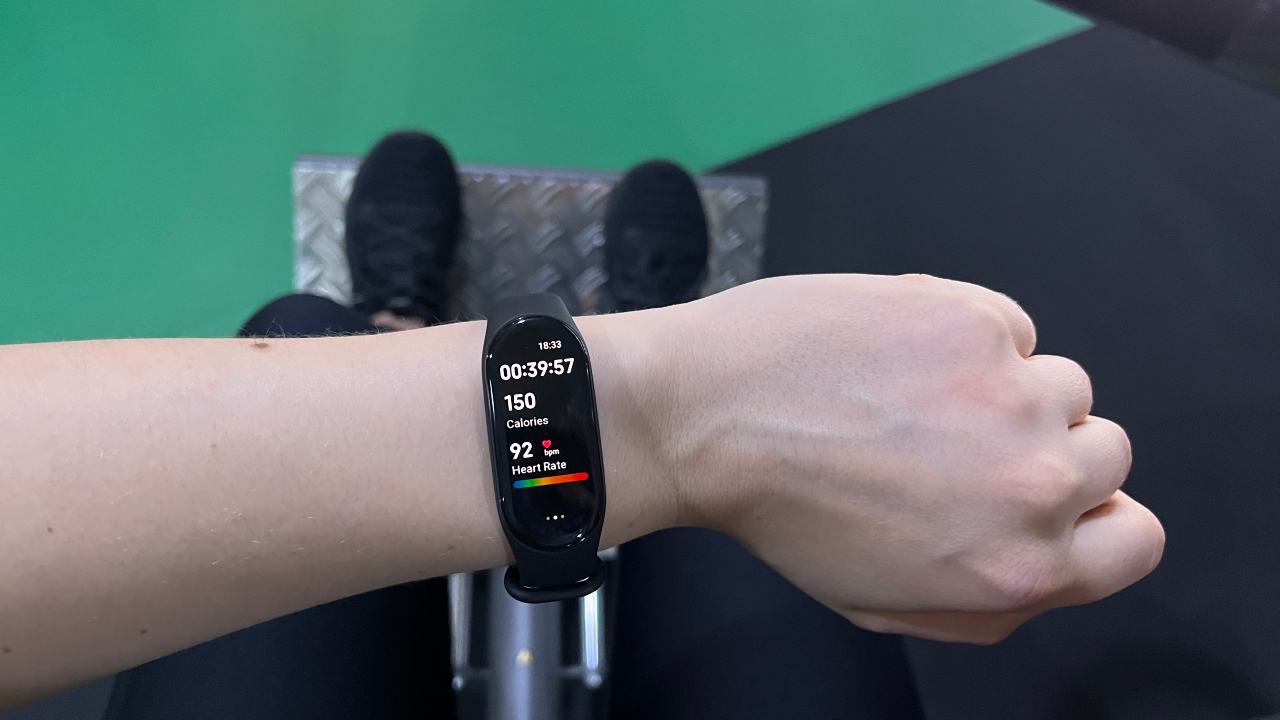
Want an affordable activity tracker? No doubt Xiaomi is on your shortlist. The Chinese manufacturer has made a name for itself with the low-cost, feature-packed Mi Band series, of which the Xiaomi Smart Band 7 is the most recent. But does the new model provide a significant upgrade on its predecessor and, as budget-friendly fitness tracker tech continues to improve, does Xiaomi still have the edge on the competition?
Xiaomi Smart Band 7: Price And Availability
The Xiaomi Smart Band 7 is available from the Xiaomi website and third-party retailers in the UK. It costs £44.99, making it one of the more budget-friendly fitness trackers currently available. In the US, the Xiaomi Smart Band 7 is available from the Xiaomi store on Amazon for $46.30.
Design
If you’re aware of previous Xiaomi bands, you’ll be familiar with the Band 7’s design: a pill-shaped screen mounted to a flexible silicone strap. The main upgrade from the previous Mi Smart Band 6 is a larger screen, with a 25% bigger viewing area. It’s a 1.62in (41mm) AMOLED high-resolution display with more than 100 custom band faces to choose from. Xiaomi has also redesigned the user interfaces, aiming to make them clearer and easier to navigate.
The touchscreen can be slow to respond to swipes and taps, which was frustrating at times. The band doesn’t automatically lock if it’s not in workout mode, although you can change this in Settings. If auto-lock isn’t on, the band can be activated by drops of water, with the result that the band erroneously started a treadmill workout when I wore it in the shower. I found the Huawei Band 7 more responsive and intuitive to use (and it’s also slightly cheaper).
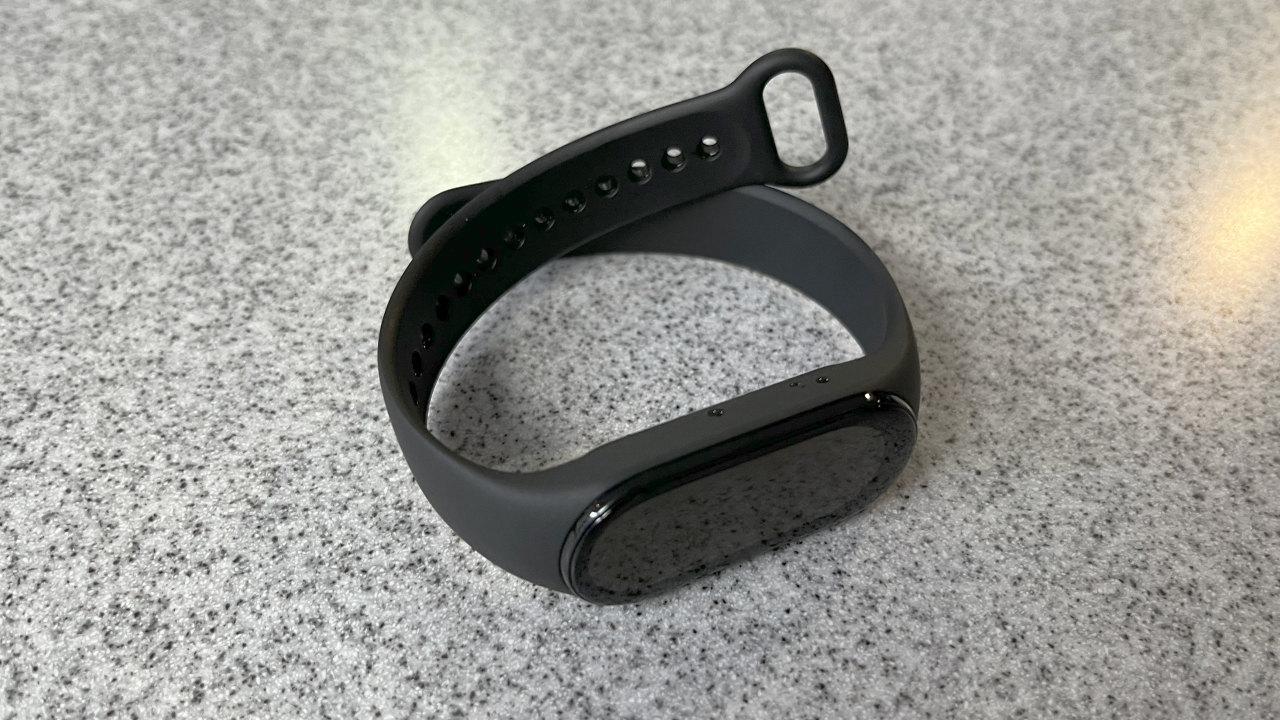
The Xiaomi Smart Band 7 is lightweight and comfortable to wear and stayed in place well for the duration of testing. It comes with a black strap (which is the model I used), but colorful straps are available to purchase separately. The strap is durable and easy to clean and didn’t show many scuffs or scratch marks after a month of wear. The band comes with a magnetic charging cable that attaches to the back of the tracker.
How I Tested This Device
I spent a month testing this band, wearing it for the majority of the day and night. I recorded several walks, runs and swims in the pool, plus yoga and strength-training sessions.
Activity Tracking
For such a budget-friendly device, the list of tracking features is lengthy. In just a few swipes on the band, you can view Personal Activity for the day, including steps, calories burned during daily activities and workouts, and standing active hours (hours during which you have stood or moved for one minute or more).
In the app, your main daily stats are shown on a rainbow-style graph, with color bars that fill up as you reach daily goals. You can also dive further into individual stats, with dedicated graphs showing sleep, heart rate, steps, calories, moving hours, standing hours, blood oxygen, stress, and more. I didn’t notice any significant errors and the band’s logs were accurate.
Sports Tracking
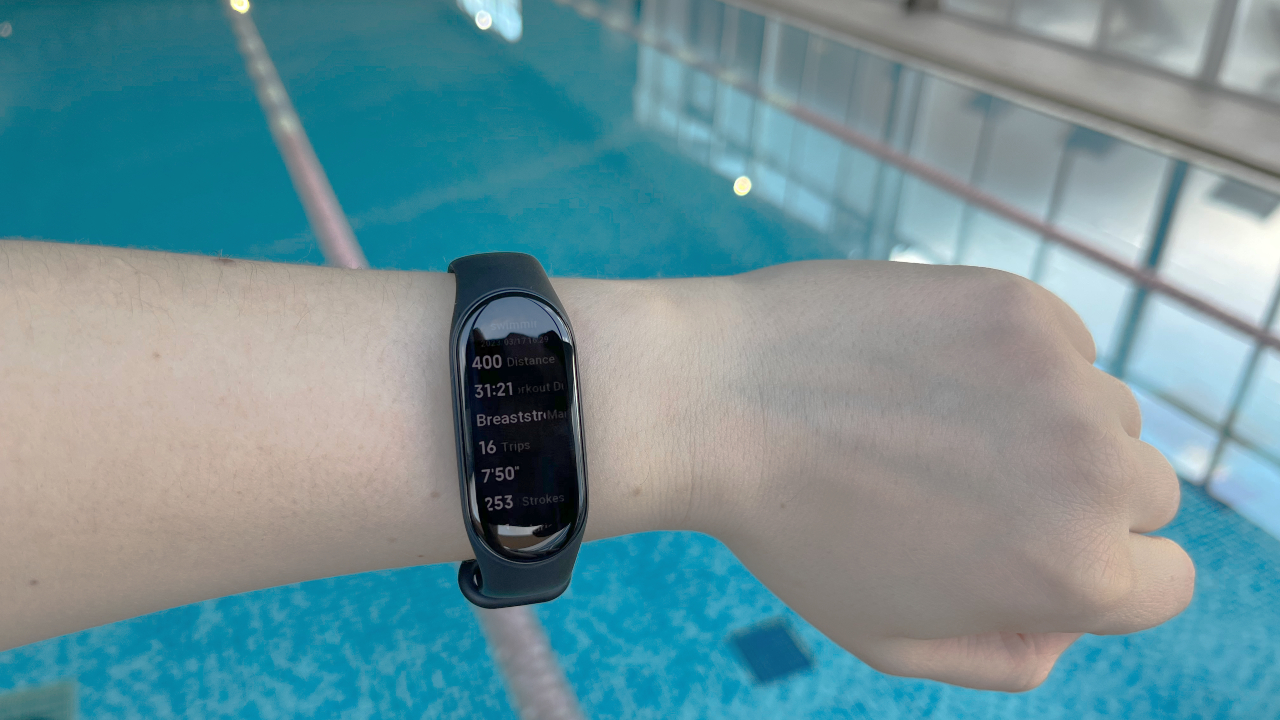
The Xiaomi Band 7 supports more than 110 sports modes including, bizarrely, chess, checkers, bridge and board games. It also covers more common workout options such as walking, running, cycling and swimming.
The band has a 5ATM water-resistance rating (50m in depth), allowing for pool swimming or shallow-water activities, and I took it to a swimming pool to test it out. The screen locks neatly when submerged in water. It detected my swimming stroke and the number of lengths as I swam. However, the screen can be temperamental when wet. I struggled to end the workout because there were drops of water on the screen, and the band was still sluggish after wiping it with a towel.
There’s no built-in GPS, which is common for trackers at this price point, but the connected GPS worked well when paired with my phone. After a walk or run you can view your route in the Mi Fitness app, along with distance, time, calories, pace, beats per minute and steps. For swimming, the stats are not as detailed, with distance, time, calories, pace, main style, lengths, average stroke rate, total strokes and laps displayed in the app.
The App
I downloaded the Mi Fitness app to my iPhone 13 and paired it with the device. During the initial set-up, many of the advanced features are disabled by default, presumably to preserve battery life—so take your time to go through the app and familiarize yourself with the options, so you can choose the ones you might like to activate.
I found the app clear and easy to use. The Health homepage has an overview of your statistics, and you can click through to each section to see more detail and access your workout history. You can also invite friends to compete on workout achievements such as daily step count, calories burned and workout time and win points every day.
Sleep Tracking
On the app you can see your overall sleep time, along with a graph showing periods of light, deep and REM sleep and the times when you’ve woken up during the night. I was concerned that the band hadn’t tracked any REM sleep for me in a week, before realizing you have to activate advanced sleep monitoring for this feature to work.
While the band’s compact and lightweight design makes it comfortable to wear to bed, there’s no ambient light sensor, so I found myself dazzled by the screen a few times during the night. This is remedied using a few swipes and taps to manually turn down the brightness, but if you’re used to the sleek experience of premium smartwatches, it may be frustrating.
Health Tracking
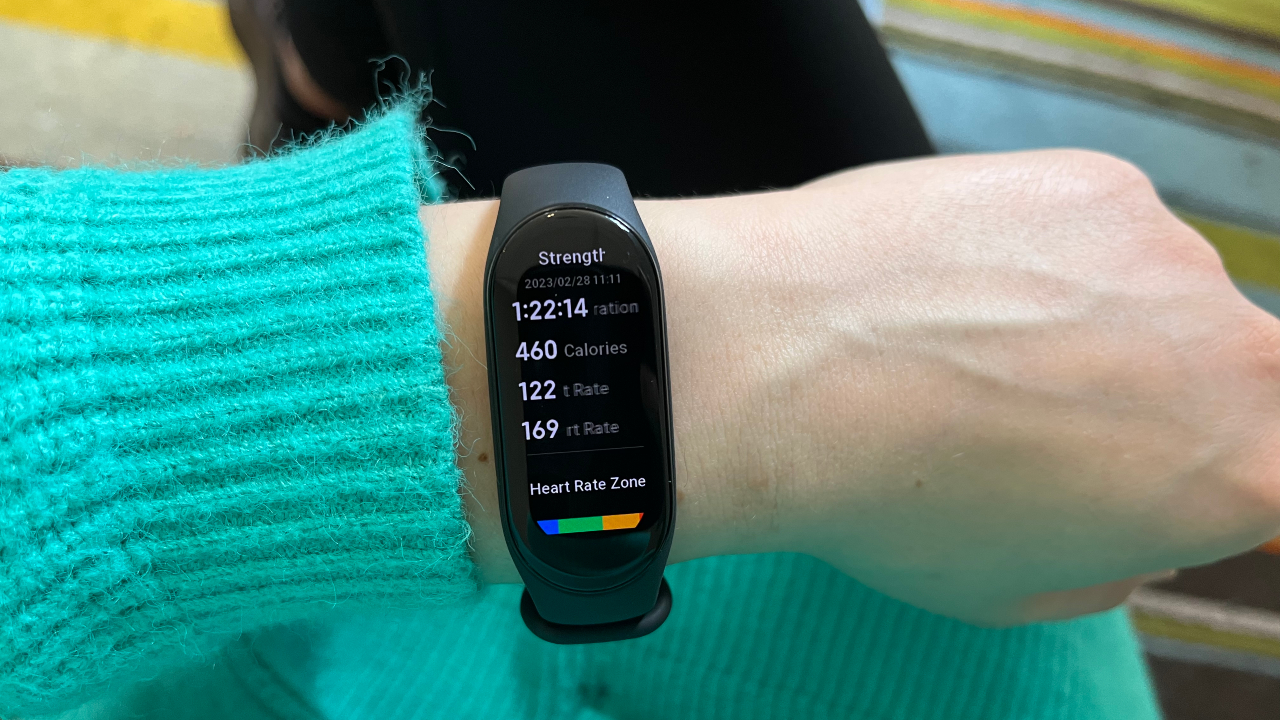
You can manually check your blood oxygen (SpO2) levels or activate all-day SpO₂ monitoring if you prefer—the band will alert you if it ever drops too low. Heart rate statistics are shown on a graph, with a daily summary of your maximum, minimum and average BPM and the total time spent in each heart rate zone.
You can track and predict your menstrual cycle using the app, with the algorithm providing an estimate of fertile windows and ovulation days. You can also set up reminders to show on your wearable device. Weight tracking is also provided, via the app: You can manually enter your weight, along with body composition percentages such as fat, water and bone mass.
Battery Life
The battery life of the Xiaomi Smart Band 7 is solid, and the app makes it easy to disable functions to save power. The most battery-draining of these is the always-on display, which Xiaomi says reduces the battery life by half.
The Smart Band 7 averages a 14-day battery life with typical usage, according to Xiaomi. It defines this as disabling advanced sleep monitoring and stress detection, enabling automatic heart rate monitoring every 30 minutes, activating the lift-wrist-to-wake function and using it 200 times a day, receiving 100 notifications a day, setting 10 alarms a day, syncing data with the app once a day, manually measuring SpO2 levels twice a day and recording exercise for 60 minutes a week.
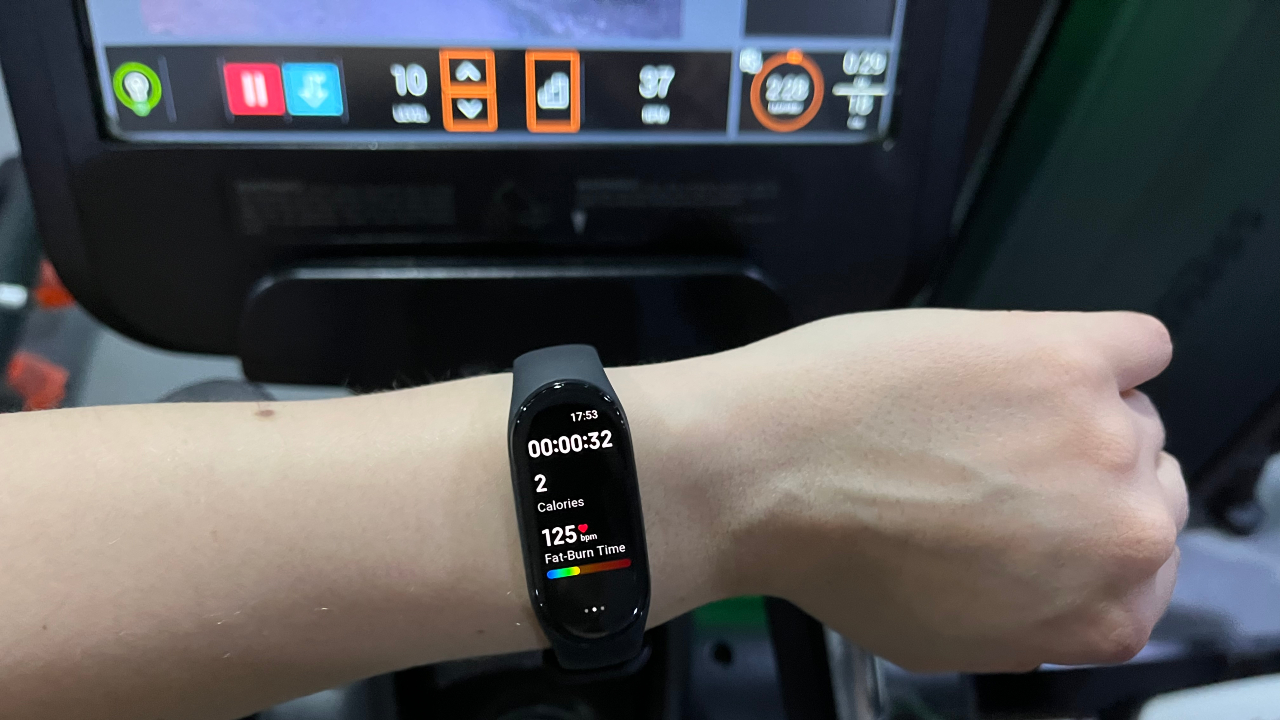
You should expect nine days of battery life with heavy use, which Xiaomi defines as automatic heart rate monitoring every minute, sleep detection activated, stress detection activated, lift-wrist-to-wake function activated and used using it 500 times a day, receiving 200 notifications a day and 15 incoming calls a day, syncing data with the app once a day, manually measuring SpO2 levels twice a day and recording exercise for 90 minutes a week.
I got 10 days out of the band with the always-on display deactivated, logging around 60 minutes of exercise a day and using a variety of other functions.
Is The Xiaomi Smart Band 7 Worth It?
There’s a lot to like about the Xiaomi Smart Band 7, and it packs a hefty punch at an accessible price point. There are lots of activity, health and fitness tracking features to explore, and the band is comfortable and durable. That said, there isn’t a big jump in specs from the Band 6 to the Band 7, so it’s likely not worth upgrading if you’re happy with what the previous model offers.
The screen can be unresponsive at times and struggles to cope when wet. Personally, I found the Huawei Band 7 easier to use and more responsive—so if I were looking to purchase at this price point, I would opt for Huawei over Xiaomi.







